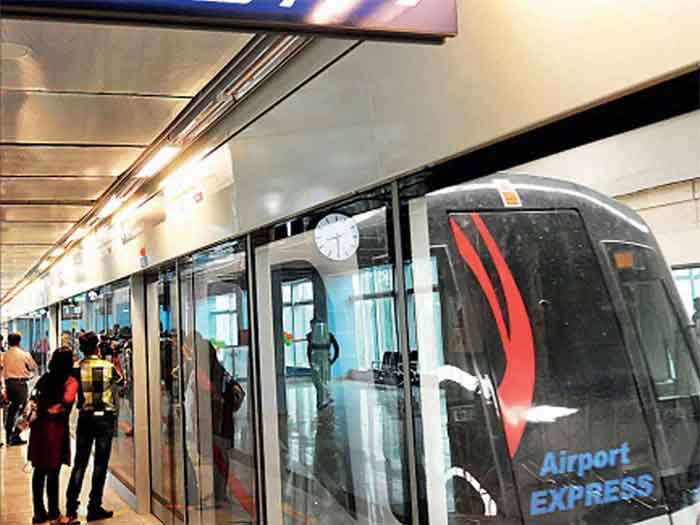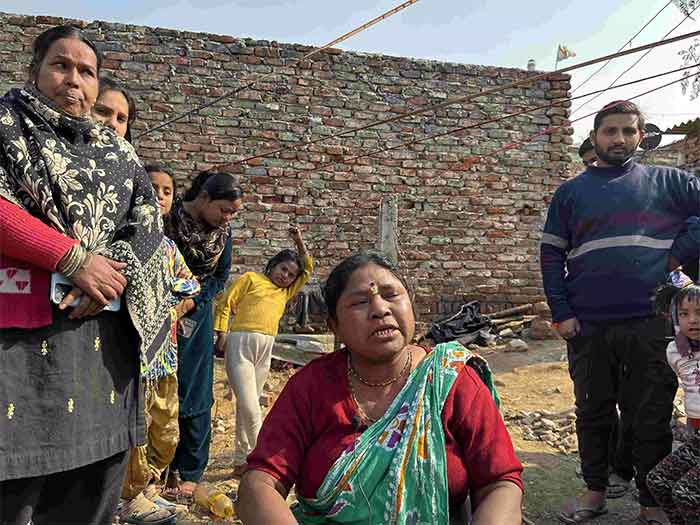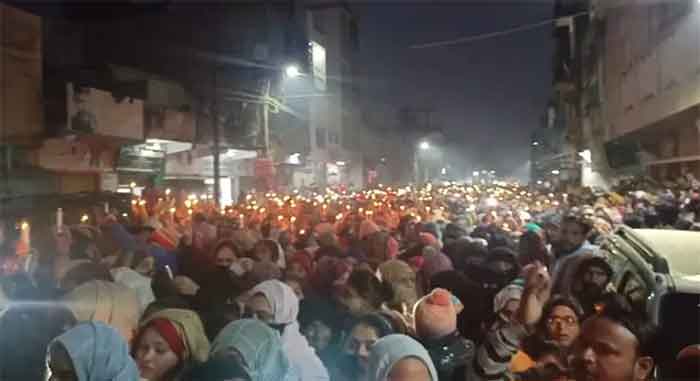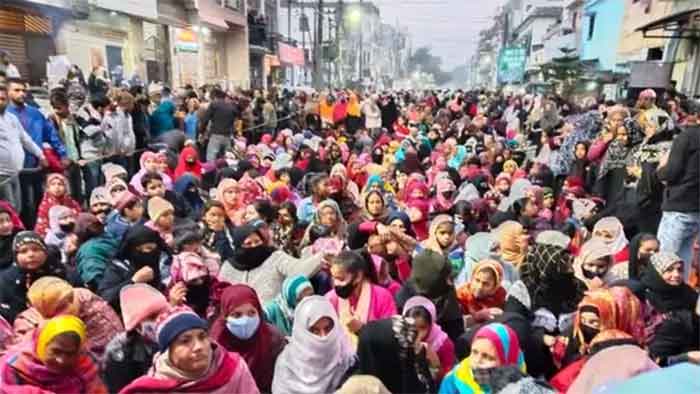
Dharavi is Asia’s biggest slum that became world famous through the Oscar-winning movie Slumdog Millionaire (2008). Located in Mumbai, the financial capital of India, it symbolises India’s stature as the ‘citadel of global poverty’ and home to world’s major chunk of poverty-stricken people with around 250 million “extreme” or “absolute” poor, 60 million of them being slum dwellers. As a corollary of this, inequality in its worst form exists in India where the top one percent of its population now owns more than 40 percent of the country’s wealth while bottom 50 percent holds only less than 3 percent of the same. Recently, when the first meeting of the Development Working Group under India’s G20 Presidency was underway in Mumbai during the second week of December 2022, alongside the drive to beautify the city, the Modi government, using big sheets, also resorted to cover-up the city’s slums including Dharavi from the sight of foreign dignitaries.
Now once again Dharavi has started getting a lot of media attention following the winning of the bid for Dharavi Redevelopment Project (DRP), one of world’s biggest “slum redevelopment plan” by Adani, India’s largest and the third-richest global corporate billionaire. As of now, out of 22 million population of Mumbai, around 42 percent is in slums and Dharavi houses more than a million people among them. The idea of providing housing to slum dwellers together with Dharavi has been there since the last decade of the of the 20th century when Shiv Sena-BJP government in 1995 announced the establishment of a Slum Rehabilitation Authority (SRP) as its poll promise envisaging “free houses” to 4 million slum dwellers. In the meanwhile, despite occasional interventions on the part of authorities, due to lack of official interest and due to the uncertainties regarding private gain, no serious initiative had been there as the project was primarily envisaged in the public domain. This had been the situation till the ascent of the Modi regime in 2014.
Since then, on account of the far-right turn in policies towards neoliberal-corporatisation, even the remnants of erstwhile Nehruvian ‘state-led development’ became an anathema as manifested in the abolition of the six-and-a-half decades old Planning Commission and the state itself transforming as a corporate-facilitator. This resulted in a shift in decision-making to corporate-board rooms as parliament remained a mere spectator leading to India’s transformation as the most flourishing example of crony capitalism led by Adani-like billionaires who merged themselves with the higher echelons of power. The new-found initiative for drastically redeveloping Dharavi through private-corporate initiative under the pseudonym of public-private-partnership (PPP) comes to the fore in this far-right neoliberal context. Thus, in continuation of many aborted attempts in the past 19 years to redevelop Dharavi, now Adani has won the “world’s largest urban renewal scheme” by clinching the Rs. 5069 crore-bid for the Rs. 23000 crore DRP which is to be finished in 17 years and rehabilitation plan of slum dwellers in 7 years.
The circumstances that led to the latest initiative are noteworthy. Obviously, as noted at the outset, the immediate context for this concern for Dharavi is India’s emergence as G20 host country and Modi government’s move to use the context as an opportunity to showcase India. Further, redevelopment of slums has been included in “Urban 20” (U20) that was initiated in December 2017 as part of G20’s Sustainable Development initiative. Equally relevant is Modi regime’s own much publicized proposal for developing “smart cities” under “public-private-partnership” (PPP), that has now become the acclaimed model of development in all spheres since it is the most convenient form of loot of public money by corporate-crony capitalists under neoliberalism. As such, the decay and parasitism of capital have reached that level where even slum renewal/redevelopment has also become an avenue of lucrative profits and corporate plunder in the guise of PPP.
Regarding the emergence of Adani Group as the ‘developer’ of Dharavi, allegations are there regarding how it became the lead bidder. For instance, in 2018 Adani was lost out to UAE- based Seclink Group backed by the Abu Dhabi Royal family that bagged the DRP in the tendering process as it quoted Rs. 7200 crore outbidding Adani who could then bid it only at Rs. 4539 crore. However, it was canceled for which satisfactory explanations are lacking. Hence in late 2022, when Adani could easily outbid the other competitors with an amount of Rs. 5069 crore, he had already become the front-ranking global billionaire and the closest corporate ally of the ruling regime. Hence it also prompts all well-meaning people to look into the modus operandi behind Adani grabbing the DRP along with the proprietorship of various PPP-based realty and infrastructure projects including ports and airports outbidding others on mere technical grounds.
Now, as already reported by many concerned, Dharavi is going to be another source of fabulous wealth appropriation for Adani whose business empire has ballooned in recent years primarily through real estate and speculation involving both large-scale displacement of the people from their habitat and outright plunder of nature. As per the agreement, in the Special Purpose Vehicle (SPV) that is being floated for DRP consisting of Adani and government (represented by both Dharavi Redevelopment Authority – DRA and Slum Redevelopment Authority – SRA), both will hold 80 percent and 20 percent equity respectively. With an investment of Rs. 5069 crore (bid amount), Adani’s interest obviously lies not in the rehabilitation of slum dwellers but in the “sale component” of the Rs. 23000 crore-project, by which he can sell lakhs of square foot of residential and commercial spaces in the very heart of the city of Mumbai. It is in addition to this that 47.5 acres of Railway land in Dadar, in central Mumbai has been handed over to Adani as an incentive, for which the Railway Ministry is set to get only a paltry 0.21 percent of the profits as per the agreement.
No doubt, the overall socio-economic impact of slum redevelopment and ‘rehabilitation’ on its residents by private developers, whose driving force is speculative profit from real estate business will be far-reaching including massive displacement of the slum dwellers. This is the logical corollary of making policy-decisions in corporate board-rooms and superimposed on the residents by the most corrupt crony capitalist regime in gross disregard of even namesake people’s participation, without seeking people’s concerns in any manner, and totally keeping them in the dark without sharing any details of the agreement between Adani and the regime. It also goes against the Maharashtra Slum Act that provides for people’s participation mandatory for slum redevelopment and rehabilitation. For the one million slum dwellers of Dharavi living there for generations in around 65000 families spread across almost 700 acres (around 283 hectares) of land, the outcome of this redevelopment led by Adani is going to be horrific as many lakhs of people will be evicted and thrown own out mercilessly.
According to available information on the deal, those who were residing in Dharavi before 2001 will be eligible for a 300/350 sq ft house (as per accepted housing guidelines, a family of five should have a minimum 700 sq ft house) and those who came after that have to buy it at a price. This criterion itself is enough to squeeze out around half of the inhabitants from rehabilitation altogether. The Dharavi renewal project earmarks 65 percent of the construction (total construction as per DRP is estimated at more than one crore sq ft) for rehabilitation and 35 percent for sale in the open market and out of 1.08 lakh houses, 40000 are for open sale. But it is only for public consumption, since the above condition will deny housing right for more than half of the residents. Further, those who are lucky to to be accommodated will be confined to a corner of the buildable area which is fixed at around 150 hectares only. To be precise, lakhs of sq ft of residential and commercial space in the heart of Mumbai city will be available to Adani under what is called Transferable Development Rights (TDR) for sale in the open market. In view of the present market price of Rs.70000 per sq ft in Mumbai’s Badra-Kurla, one of the most prominent business complexes in Asia that is adjacent to Dharavi, the latter is definitely going to be a ‘gold mine’ for Adani!
At the same time, Dharavi is not an ordinary slum, but has a sustaining informal economy with an annual turn over of more than Rs. 8000 crore and providing employment to many lakhs of its residents. It is a hub of tens of thousands of unorganised enterprises manufacturing a wide variety of products such as leather, footwear, textiles, cloths, pottery and even medicines. It is estimated that garments making alone gives livelihood to around 2 lakh people. Thousands of small units employing around 25000 people are engaged in sorting out and recycling almost 80 percent of Mumbai’s solid waste. Probably, Dharavi may be India’s most literate and educated slum which created history effectively resisting the Covid pandemic while Modi regime was busy with superimposing world’s most stringent lockdown on the people. Now, in the guise of Adani-led redevelopment and rehabilitation, this ‘ecosystem’ is going to be destroyed leading to a new ‘ghettoisation’ of Dharavi, even as half of the residents being ‘ineligible’ will be evicted and thrown out with the backing of state power, as exemplified by the notorious Vizhinjam port project in Kerala, which is destined to be nonviable both economically and ecologically. [https://countercurrents.org/2022/12/cpim-and-bjp-become-twin-brothers-in-kerala-in-their-ignominious-servility-to-adani/]
For the Adani conglomerate, Dharavi is only the latest in the series of construction projects undertaken by it. As in the case of his entry into other sectors, Adani’s realty tentacles also have their roots in Gujarat beginning with the construction of Shantivan township in Ahemadabad since 2010 when Modi was the chief minister of Gujarat. This was followed by construction projects in Jagatpur, Gurugram and Pune, and it was in 2014 along with the advent of the Modi regime at the Centre and the consequent pan-Indian extrapolation of Gujarat model that enabled Adani to extend his realty empire to Mumbai, India’s financial capital in 2014. These realty projects which are under PPP are also categorised as infrastructure investments today. Hence, together with government grants, many tax and fee concessions, Adani (and others of his kind also) can avail thousands of crore of bank loans for such realty businesses on the basis of mere ‘good-will’ which are eventually written off as Non-Performing Assets (NPAs) leading to unprecedented crisis of public sector banks in India, a fact recently acknowledged by the RBI Report itself.
Of course, reminiscent of the ‘robber barons’ of the colonial era, the ‘new generation’ Indian corporate billionaires with Adani now in the lead are accumulating fabulous wealth primarily concentrating in money-spinning businesses such as stock market, real estate and outright plunder of nature rather than from the productive sectors of the economy. As a result, even when the real economy goes through a downward spiral, as was the case during the pandemic when people were in held in captivity through many restrictions, the most corrupt crony capitalists with their unholy alliance with the regime are able to gallop their wealth by sucking out whatever left in the arteries of common people by remaining in the sphere of speculation. Obviously, on account of his close proximity and nexus with Modi, Adani has been the most successful crony capitalist in this process. This has been the political basis of his success in many controversial deals pertaining to projects such as coal mines (including the controversial Australian deal), power generation, transmission and distribution, gas distribution, agribusiness, ports, airports, financial services, media, digital services and data centres, and many other infrastructural and real estate projects. No doubt, this gobbling up of country’s resources is backed by a series of pro-corporate laws, fiscal and monetary measures including many tax exemptions and corporate tax reductions. The other side of this corporate logic as already mentioned, is the manner in which many millions are driven to hitherto unknown levels of poverty, deprivation and destitution.
Therefore, when Adani, the epitome of ‘crony capitalism’ now becomes the ‘developer’ of Dharavi, dark days are ahead for its one million residents whose ancestors got a 99-year land lease agreement for settling there from the colonial government in 1895. The superimposed DRP which is in tune with corporate greed in gross disregard of the concerns and requirements of the dwellers of Dharavi is part of the corporate-fascist offensive unleashed on the working class and oppressed by the Modi regime throughout the country. Therefore, in view of the impending socio-economic tensions related to this deal, the political developments in India in the coming days including the 2024 General election will be decisive for the people of Dharavi as well as for DRP led by Adani.
P J James is general secretary of CPI ML (Red Star)















































